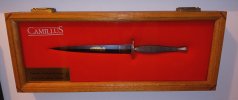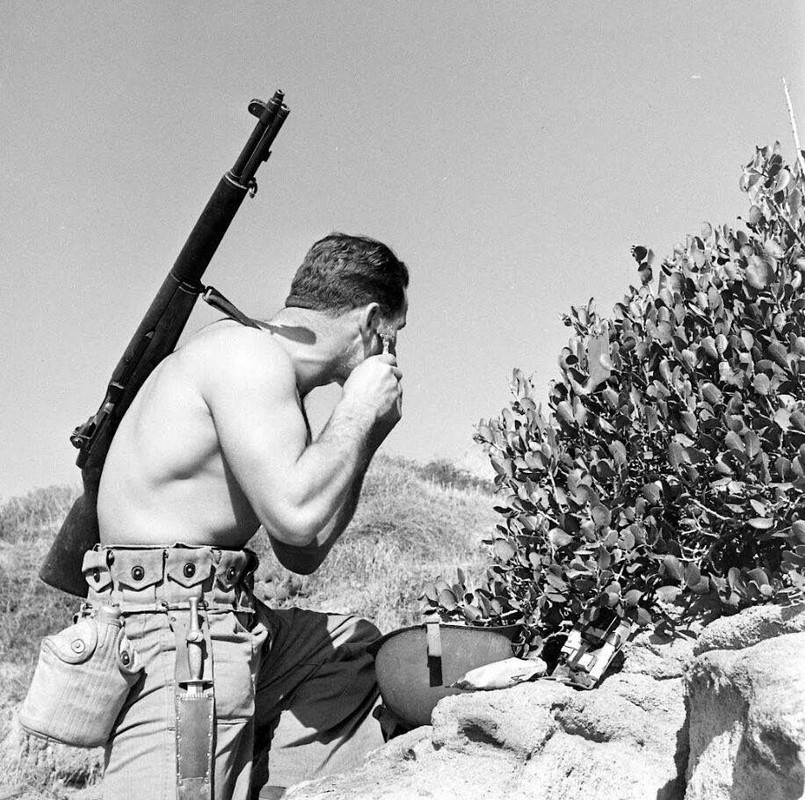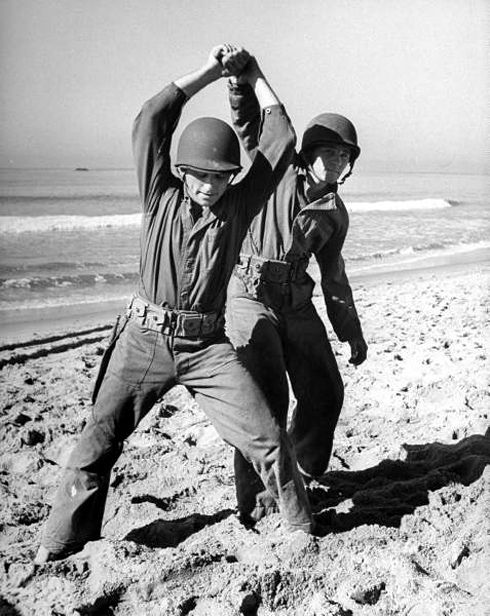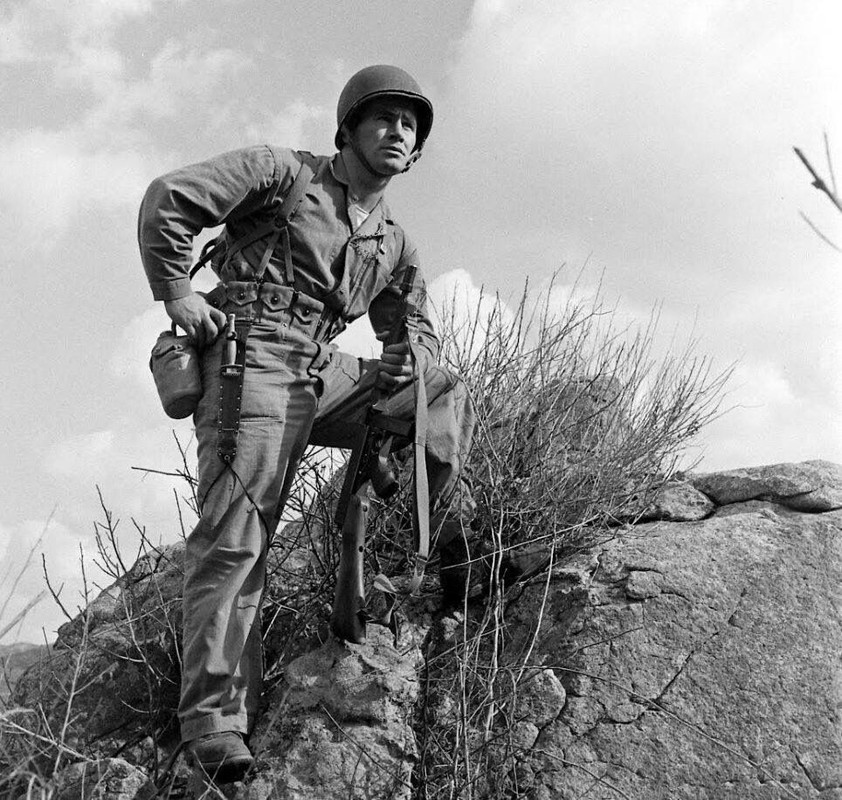As I was working on my WW2 blade collection, I unexpectedly became interested in high quality USMC Raider Stiletto reproductions such as those once offered by Camillus Cutlery, HG Long, Case Cutlery, and commissioned by the Marine Raider Association/Historical Associates. These are much more affordable than the original stilettos with the added benefit of being more amenable to frequent handling. Here are the four I have been able to study and compare:
#1. Camillus Cutlery New York: U.S. Marine Raider Stiletto (Ltd edition of qty 2,000).
Sometime around 1967, the original maker of the genuine 1942 classic that was issued to USMC Raiders, Paramarines, and Canadian Patatroopers, found a barrel of new old stock (NOS) high-carbon stamped tool steel blades. They meticulously ground these blanks into the original double-edged diamond profile with a needle tip and mated them with an improved pewter handle cast from molds made with an original specimen now preserved in the Raider Museum in Richmond. As such, this knife exhibits exacting details of the original WW2 stiletto including all handle relief patterns and even the rather shallow etched “USMC” and “Camillus Cutlery Co Camillus New York” maker’s mark on the same side of 7-1/8 inch blade. The blade is darkened and these etchings are in gold rather than in black as was found on the bright blade of the original stiletto. The M6 style leather sheath is light brown. A red velvet-lined lockable oak and glass display box was included. Apparently, a similar model was made in the 90’s before Camillus closed shop for good in 2007, using newly manufactured blades but with the Camillus logo replacing the USMC etching. Neither of these are currently in production.
#2. HG Long of Sheffield England: Officially Authorized Marine Raider Commemorative Edition (Ltd to 2500). This is not as true to original details as the Camillus, but it is an elegant and very nice stylized late 20th Century version offered by a famous British manufacturer of Fairbairn/Sykes style Commando knives. This is appropriate because the Original USMC Raiders have roots in the WW2 Commando Training Center in Scotland. I am not sure why HG Long was chosen at the time the Raider Association commissioned them, but Camillus has since closed up shop. The 6-7/8 inch bright blade is more of a spear-point than needle tip as found in the original. There is a fantastic and high relief “USMC” etching on one side of blade and the HG Long Maker’s Mark on the obverse side of blade, reminiscent of the Wilkinson’s Sword F/S models. A detailed miniature 1st MAC Raider insignia is inlaid with enamel into an amazingly beautiful Sterling Silver-plated pewter handle. The blade is serialized and came with a signed Certificate of Authenticity, and a dark Walnut storage box also exhibiting the Marine Raider MAC Patch likenesses inside and out. A quality red velvet liner nicely accents the ensemble. The M6 style sheath is brown leather. These were often presented to individual Marines and units such as Force Recon by the Raider Association prior to the founding of MARSOC. No longer in production.
#3. Historical Associates of Richmond Virginia:
Marine Raider 75th Anniversary Edition Stiletto. This one is sort of a hybrid of the first two. On one hand, it is true to the original Camillus style form overall but with the addition of a special 75th Anniversary etching on the double-edged stainless steel blade. Like the other HG Long version above, this one has a maker’s mark on the opposite side of the blade. Also like the Camillus version above, this hilt is individually hand cast with a half pound of improved pewter alloy using an in-house mold made from an identified authentic WW2 Raider Stiletto. An oak storage case is available as an added accessory. This knife is still available for purchase, but is hand made to order and takes several weeks. They also offer an outstanding Raider pictorial essay book titled, “ Our Kind Of War” that details nearly everything about America’s Original Special Operations Commando Force, the U.S. Marine Raiders.
(http://www.historicalassociates.com/75th AnniverStiletto.htm)
#4. Case Cutlery XX:
Marine Raider Commemorative Edition. Apparently, Case was in the running for the original 1942 government contract but lost out to Camillus for the Marine issued Stiletto. Apparently, some “proof of concept” models were actually made and submitted during the war, so it is fitting that this commemorative model exists for comparison of what could have been. Of course, Case made many other important WW2 knives, including the legendary V42 Stiletto issued to the joint U.S./Canada First Special Services Group (Black Devils). The style of this commemorative is quite elegant and more faithfully evokes the British F/S Commando Stiletto than does the Camillus model. This is particularly true in Case’s use of a substantial eye-catching ricasso where the 7-1/4 inch blade meets the hilt. This model often has a Pearl Harbor etching or some other commemorative logo and may still be available upon request from Case Cutlery, but I’m not sure. Arizona Custom Knives used to make a similar knife as well.
Conclusion:
Although I am clearly partial to the Commemorative models that are truest to the genuine issued Raider pattern, these are all very nice, high quality reproductions. IMHO, they are all well-worth the $300+ investment because of the exhibited workmanship, history, and durability. These knives all have the knurled “Coke bottle” handle as originally designed by Marine Colonel Shuey, and are of presentation and display quality. They will likely outlast the wartime issued USMC Raider Stilettos given the known durability issues with the original blades and handles. Fortunately, both the Camillus and the Historical Associates models were made with molds created from the originals and they may provide a template for recasting the original Zinc Alloy handles if they continue to deteriorate as they approach nearly a century of existence. Perhaps through purification of the crumbling remnants or the addition of pewter or Titanium to the remaining original alloy will ensure that the iconic originals and the heroic warriors they represent live on into infinity.
USMC Raider Commemorative Stilettos
#1. Camillus Cutlery New York: U.S. Marine Raider Stiletto (Ltd edition of qty 2,000).
Sometime around 1967, the original maker of the genuine 1942 classic that was issued to USMC Raiders, Paramarines, and Canadian Patatroopers, found a barrel of new old stock (NOS) high-carbon stamped tool steel blades. They meticulously ground these blanks into the original double-edged diamond profile with a needle tip and mated them with an improved pewter handle cast from molds made with an original specimen now preserved in the Raider Museum in Richmond. As such, this knife exhibits exacting details of the original WW2 stiletto including all handle relief patterns and even the rather shallow etched “USMC” and “Camillus Cutlery Co Camillus New York” maker’s mark on the same side of 7-1/8 inch blade. The blade is darkened and these etchings are in gold rather than in black as was found on the bright blade of the original stiletto. The M6 style leather sheath is light brown. A red velvet-lined lockable oak and glass display box was included. Apparently, a similar model was made in the 90’s before Camillus closed shop for good in 2007, using newly manufactured blades but with the Camillus logo replacing the USMC etching. Neither of these are currently in production.
#2. HG Long of Sheffield England: Officially Authorized Marine Raider Commemorative Edition (Ltd to 2500). This is not as true to original details as the Camillus, but it is an elegant and very nice stylized late 20th Century version offered by a famous British manufacturer of Fairbairn/Sykes style Commando knives. This is appropriate because the Original USMC Raiders have roots in the WW2 Commando Training Center in Scotland. I am not sure why HG Long was chosen at the time the Raider Association commissioned them, but Camillus has since closed up shop. The 6-7/8 inch bright blade is more of a spear-point than needle tip as found in the original. There is a fantastic and high relief “USMC” etching on one side of blade and the HG Long Maker’s Mark on the obverse side of blade, reminiscent of the Wilkinson’s Sword F/S models. A detailed miniature 1st MAC Raider insignia is inlaid with enamel into an amazingly beautiful Sterling Silver-plated pewter handle. The blade is serialized and came with a signed Certificate of Authenticity, and a dark Walnut storage box also exhibiting the Marine Raider MAC Patch likenesses inside and out. A quality red velvet liner nicely accents the ensemble. The M6 style sheath is brown leather. These were often presented to individual Marines and units such as Force Recon by the Raider Association prior to the founding of MARSOC. No longer in production.
#3. Historical Associates of Richmond Virginia:
Marine Raider 75th Anniversary Edition Stiletto. This one is sort of a hybrid of the first two. On one hand, it is true to the original Camillus style form overall but with the addition of a special 75th Anniversary etching on the double-edged stainless steel blade. Like the other HG Long version above, this one has a maker’s mark on the opposite side of the blade. Also like the Camillus version above, this hilt is individually hand cast with a half pound of improved pewter alloy using an in-house mold made from an identified authentic WW2 Raider Stiletto. An oak storage case is available as an added accessory. This knife is still available for purchase, but is hand made to order and takes several weeks. They also offer an outstanding Raider pictorial essay book titled, “ Our Kind Of War” that details nearly everything about America’s Original Special Operations Commando Force, the U.S. Marine Raiders.
(http://www.historicalassociates.com/75th AnniverStiletto.htm)
#4. Case Cutlery XX:
Marine Raider Commemorative Edition. Apparently, Case was in the running for the original 1942 government contract but lost out to Camillus for the Marine issued Stiletto. Apparently, some “proof of concept” models were actually made and submitted during the war, so it is fitting that this commemorative model exists for comparison of what could have been. Of course, Case made many other important WW2 knives, including the legendary V42 Stiletto issued to the joint U.S./Canada First Special Services Group (Black Devils). The style of this commemorative is quite elegant and more faithfully evokes the British F/S Commando Stiletto than does the Camillus model. This is particularly true in Case’s use of a substantial eye-catching ricasso where the 7-1/4 inch blade meets the hilt. This model often has a Pearl Harbor etching or some other commemorative logo and may still be available upon request from Case Cutlery, but I’m not sure. Arizona Custom Knives used to make a similar knife as well.
Conclusion:
Although I am clearly partial to the Commemorative models that are truest to the genuine issued Raider pattern, these are all very nice, high quality reproductions. IMHO, they are all well-worth the $300+ investment because of the exhibited workmanship, history, and durability. These knives all have the knurled “Coke bottle” handle as originally designed by Marine Colonel Shuey, and are of presentation and display quality. They will likely outlast the wartime issued USMC Raider Stilettos given the known durability issues with the original blades and handles. Fortunately, both the Camillus and the Historical Associates models were made with molds created from the originals and they may provide a template for recasting the original Zinc Alloy handles if they continue to deteriorate as they approach nearly a century of existence. Perhaps through purification of the crumbling remnants or the addition of pewter or Titanium to the remaining original alloy will ensure that the iconic originals and the heroic warriors they represent live on into infinity.
USMC Raider Commemorative Stilettos
Last edited:




